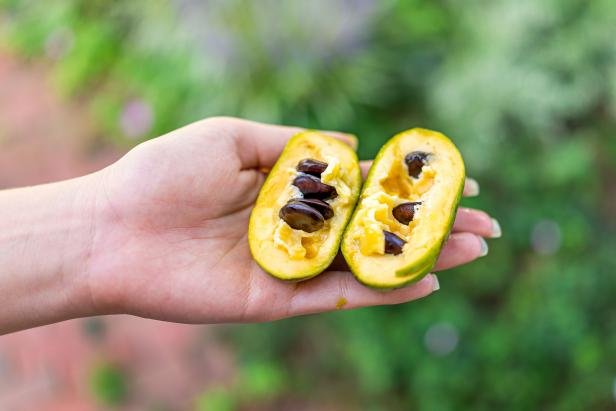Discovering Virginia's Elusive State Fruit
Monica Sandu '24
Production Editor
Florida oranges. Georgia peaches. Maine blueberries. Nearly every state has its own official fruit, a symbol of horticultural pride and agricultural delight. But despite living in Virginia since I was three, I recently came to the realization that I had no clue what Virginia’s state fruit actually was! Could it be the huckleberry, like Montana?[1] Was it a variety of apple, like so many other states? Surely it couldn’t be the tomato.[2] I was wrong on all accounts. The state fruit of Virginia? The pawpaw.
Pictured: A cut pawpaw fruit
Photo Credit: Food Network
Ok, so it’s not Virginia’s official state fruit.[3] Virginia doesn’t actually have an official fruit, though it does have, among others, an official beverage (milk), official rock (Nelsonite),[4] and even an official motor sports museum (Wood Brothers Racing Museum and Virginia Motor Sports Hall of Fame).[5] In 2020, to remedy this fruitless oversight, Virginia House of Delegates Representative Elizabeth Guzmán filed a bill proposing the adoption of the pawpaw as the official state fruit of Virginia.[6] But what is the pawpaw?
Bearing the largest edible fruit native to North America, the pawpaw is a small understory tree and “the only local member of a large, mainly-tropical plant family,” according to the National Park Service.[7] The fruit is at peak ripeness in September through late October and resembles a small papaya, with a flavor described as “banana-like with hints of mango, vanilla, and citrus” and a pale yellow pulp that has been called “a natural custard.”[8] One botanist even wrote that pawpaw fruit is “rather cloying to the taste and a wee bit puckery.”[9]
The pawpaw goes by many names, including the “poor man’s banana,” the “Quaker delight,” and the “hillbilly mango.”[10] From Kansas to the Chesapeake and the Great Lakes down to Georgia, the pawpaw’s natural range covers most of the central and eastern United States.[11] For centuries, Native Americans cultivated it for both its fruit and fibrous bark; in fact, the scientific name for the pawpaw, Asimina triloba, comes from the Powhatan word assimina.[12] Chilled pawpaw fruit was said to be one of George Washington’s favorite desserts, and Thomas Jefferson had pawpaw trees planted at Monticello.[13] With such a long history, why do we not see pawpaw fruit besides our peaches and plums today?
The short answer: commercialized agriculture. More specifically, pawpaw doesn’t store well. Even when refrigerated, fresh pawpaw fruit will only keep up to a week, and that time goes down to a mere two or three days at room temperature.[14] Furthermore, the fruit bruises very easily, so it is extremely difficult to ship if not frozen.[15]
It is also worth noting that the pawpaw has been designated a plant of “low severity poison characteristics” because ingesting the fruit’s outer skin or seeds causes stomach and intestinal pain; mechanical separation can easily contaminate the otherwise safe-to-eat pulp.[16] The pawpaw’s leaves can also cause skin irritation.[17] In addition, the tree’s small purple flowers “emit a faint odor of rotting meat or rotting, fermenting fruits” when they bloom, since its pollinators are mostly scavenger insects like blow flies and carrion beetles.[18] Overall, the pawpaw is simply unable to compete with apples, oranges, and other grocery store staples mass cultivated nationwide.
However, that does not mean that the pawpaw of today is useless. Far from it! The tree has “no serious insect or disease problems,” meaning its cultivation requires little to no pesticides.[19] Because they prefer wet soil and “multiply to form dense and well-rooted thickets,” pawpaw trees can protect vulnerable areas from erosion and runoff.[20] Furthermore, areas where the pawpaw grows are less likely to suffer deforestation due to logging since pawpaw wood does not have any real commercial uses.[21]
The pawpaw is an important food source for its local ecosystem. Birds, squirrels, opossums, and raccoons all eat the fruit, while the zebra swallowtail, Tennessee’s state butterfly,[22] feeds exclusively on pawpaw leaves.[23] In contrast, the pawpaw’s irritant sap causes herbivores to stay away.[24] This means that pawpaw trees can be used to restore forest understory in places where deer would otherwise decimate the vegetation.[25]
Pawpaw fruit are also extremely nutritious, with three times the vitamin C of an apple, potassium comparable to a banana, one and a half times as much calcium as an orange, and all of the essential amino acids.[26] They definitely appear to be worth your time…if you can find them. But that, my friends, is a story for another article.
---
ms7mn@virginia.edu
[1] https://en.m.wikipedia.org/wiki/List_of_U.S._state_foods. See also, The Huckleberry Trail.
[2] The tomato is the official state fruit of Arkansas, Ohio, and Tennessee. Id.
[3] Although it is the official state native fruit of Ohio, a totally different category from the state fruit. Id. The pawpaw tree is also Missouri’s official state fruit tree. See, https://mdc.mo.gov/discover-nature/field-guide/pawpaw (hereinafter MDC Field Guide).
[4] Named after Nelson County, Virginia, but of no apparent relation to our esteemed professor here at UVA Law. https://en.wikipedia.org/wiki/Nelsonite.
[5] Code of Virginia, §1-510. Official emblems and designations.
[6] https://www.virginiamercury.com/blog-va/pawpaws-may-become-virginias-official-state-fruit-whats-behind-their-rise-in-popularity/.
[7] https://www.nps.gov/articles/pawpaw.htm.
[8] https://en.wikipedia.org/wiki/Asimina_triloba.
[9] Werthner, William B. (1935). Some American Trees: An intimate study of native Ohio trees. New York: The Macmillan Company. pp. xviii + 398 pp.
[10] https://en.wikipedia.org/wiki/Asimina_triloba.
[11] https://plants.usda.gov/home/plantProfile?symbol=ASTR.
[12] https://gardens.si.edu/learn/blog/way-down-yonder-in-the-paw-paw-patch/. In 1612, a Jamestown settler transcribed Assimina as “wheat plum.” Other languages’ words for the pawpaw include tózhaⁿ hu in Kansa, umbi in Choctaw and riwahárikstikuc in Pawnee. See, MDC Field Guide.
[13] https://en.wikipedia.org/wiki/Asimina_triloba.
[14] Id.
[15] Id.
[16] https://plants.ces.ncsu.edu/plants/asimina-triloba/.
[17] Id.
[18] MDC Field Guide.
[19] https://www.missouribotanicalgarden.org/PlantFinder/PlantFinderDetails.aspx?kempercode=b500.
[20] https://en.wikipedia.org/wiki/Asimina_triloba#Range_and_ecology.
[21] Id.
[22] https://sos.tn.gov/civics/pages/tennessee-state-symbols#insects.
[23] MDC Field Guide.
[24] Id.
[25] https://en.wikipedia.org/wiki/Asimina_triloba#Range_and_ecology.
[26] https://web.archive.org/web/20191230230839/https://kysu.edu/academics/cafsss/pawpaw/pawpaw-description-and-nutritional-information/.

